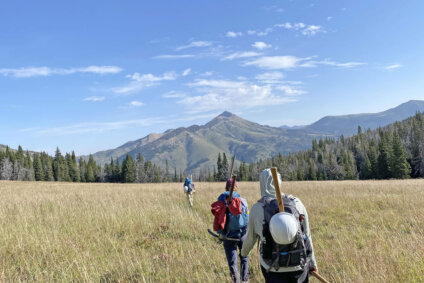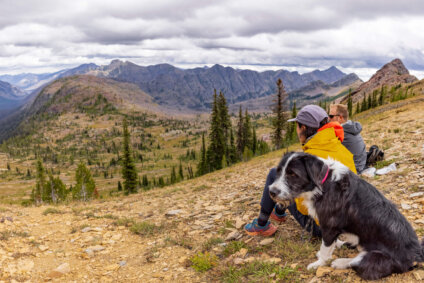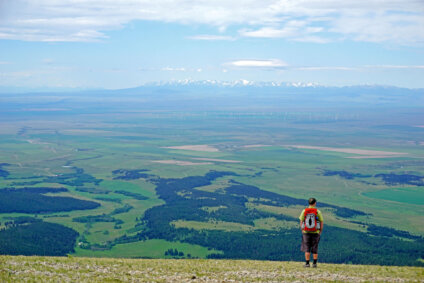Five Places to Explore Montana’s Indigenous Culture and History
These 5 sites provide an introduction to Montana's Indigenous history and culture

Indigenous peoples have lived across what is today Montana since time immemorial, shaping its landscape and culture. Today, the state is home to eight reservations, twelve tribal nations, and vibrant Indigenous communities totaling around 64,000 people.
In many cases, Indigenous history and culture, both modern and historical, are closely tied to today’s public lands. Montana’s peaks, prairies, rivers, badlands, and forests continue to be places where Pikuni (Blackfeet), Apsáalooke (Crow), Séliš (Salish), Ktunaxa ɁamakɁis (Kootenai), and many more hunt, fish, gather plants, and engage in traditional ceremonial and spiritual practices.
Across the state, there are numerous opportunities to learn about Montana’s Indigenous culture and history while you explore Montana’s public lands, trails, and natural beauty. I’ve compiled five of my favorites, but this list barely scratches the surface, and I’d encourage you to use it as a starting point for your own learning.
As you read, I’d also encourage you to use this Native land map to help you identify the Indigenous territories on which you live, work, and play.
First Peoples Buffalo Jump State Park
Location: Ulm
First Peoples Buffalo Jump State Park is home to one of the largest pishkuns (a Blackfeet word for buffalo jump) in North America. A’aninin (Gros Ventre), Assiniboine, Cree, Kalispel, Pikuni (Blackfeet), Séliš (Salish), and Shoshone people would drive the buffalo over the mile-long cliff. Today, you can hike to the top of the pishkun and see where the buffalo would have stampeded, along with the remnants of over 250 stone piles marking the “drive lines” that funneled the animals over the cliff. You can also take in beautiful expansive views of the sweeping prairie grasslands and explore the park’s large visitor center, where you can learn more about the history of the buffalo and the tribes that hunted here.
Awaaxawippíia (Crazy Mountains)
Explore trails in Awaxaawippíia
The Apsáalooke (Crow) people have long considered Awaxaawippíia (the Crazy Mountains) sacred and an important part of the tribe’s cultural heritage; the range is an important site of vision quests and other traditions in Apsáalooke culture that go back centuries. Rising above the plains to heights of over 11,000 feet, these stunning mountains also provide key habitat for animals like mountain goats, wolverines and pikas, and various bird species.
During Custer Gallatin National Forest forest planning process, we stood with Apsáalooke tribal members and officials to press the Forest Service to protect parts of the range from any development and from any motorized or mechanized use. As you enjoy the beauty of these mountains, I hope you’ll keep in mind their historical and contemporary importance and consider learning more about their cultural and spiritual significance.
Two Eagles Interpretive Trail
Location: Bighorn Canyon
Length: ¼ mile
Elevation gain: 13 feet
More trail details →
The Bighorn Canyon National Recreation Area runs along 70 miles of the Bighorn River, stretching from the Crow Reservation in southern Montana into northern Wyoming. The area is full of unique geologic formations, towering red cliffs, fossils, and numerous recreation opportunities.
It’s also a place with a rich cultural history and connection to Montana’s native people, especially the Apsáalooke (Crow) tribe. On the short, flat, and paved Two Eagles Interpretive Trail, you can see the archaeological remains of more than 140 stone tipi rings, which Apsáalooke people used to hold down the edges of their tipis when camped in the area (please don’t touch any artifacts). Using radiocarbon dating, archaeologists have determined that the oldest of these rings dates from 700 C.E. Twelve interpretive signs provide a wealth of information along the quarter-mile loop.
Madison Buffalo Jump State Park
Location: Three Forks
Length: 3.1 miles
Elevation gain: 725 feet
More trail details →
The second pishkun on the list, Madison Buffalo Jump State Park overlooks the beautiful Madison River Valley. Multiple tribes hunted buffalo here for many years, until the arrival of horses and the development of new hunting techniques made the jump mostly obsolete. Today, archaeologists continue to find bones at the base of the cliff, and tipi rings are still visible at the top. You can learn about the history of the site from the interpretive pavilion at the base of the cliff, or wander along a 3.1-mile roundtrip loop that brings you to the cliff edge. The park also provides pleasant opportunities for a relaxing picnic or a day of birdwatching.
Medicine Rocks State Park
Location: Ekalaka
Length: 0.1 – 0.7 miles
Elevation gain: up to 200 feet
More trail details →
The trails that wind through Medicine Rocks State Park are an opportunity to get an up-close glimpse of this unique “prairie island” featuring 60- to 80-foot sandstone pillars, carved with holes and tunnels by the wind. Some feature rock art by Indigenous people including the A’aninin (Gros Ventre), Arikara, Assiniboine, Tsitsistas (Cheyenne), Apsáalooke (Crow), Mandan, and Očhéthi Šakówiŋ (Sioux). The tribes who visited or lived near the site considered the area holy, and some would fast and undertake vision quests amongst the formations.
Today, the state manages the area as a primitive park with a handful of campsites, tables, toilets, and fire rings. The vast majority of the medicine rocks are within the park’s boundaries, though a few remain outside, and you can explore them along three trails, all of which are under .7 miles long. As you wander, look for native prairie plants like creeping juniper, ponderosa, yucca, phlox, prairie star, and yellow violets. Also keep an eye out for coyotes, pronghorn, red foxes, eagles, kestrels, and other birds of prey.
Stay Connected
"(Required)" indicates required fields


